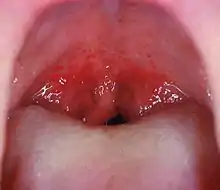Petechia
A petechia (pl. petechiae) is a small (1–2 mm) red or purple spot on the skin or conjunctiva, caused by a minor bleed from broken capillary blood vessels.[1] The word is derived from Latin 'petigo', meaning ‘scab' or 'eruption’.
| Petechia | |
|---|---|
| Other names | Petechiae |
 | |
| Petechia and purpura on the low limb due to medication-induced vasculitis | |
| Pronunciation |
|
| Specialty | Rheumatology |
Petechia refers to one of the three descriptive types of hematoma differentiated by size, the other two being ecchymosis and purpura. Ecchymosis is defined as hematomas larger than 1 centimetre[1] and purpura as 1–5 millimetres.[2]
The term is almost always used in the plural (petechiae), since a single lesion is seldom noticed or significant.
Causes
Physical trauma
The most common cause of petechiae is through physical trauma such as a hard bout of coughing, holding breath, vomiting, or crying, which can result in facial petechiae, especially around the eyes. Such instances are harmless and usually disappear within a few days.
- Constriction, Asphyxiation – Petechiae, especially in the eyes, may also occur when excessive pressure is applied to tissue (e.g., when a tourniquet is applied to an extremity or with excessive coughing or vomiting).
- Sunburn, childbirth, weightlifting[3]
- Gua Sha, a Chinese treatment that scrapes the skin
- High-G training
- Hickey
- Asphyxiation
- Choking game
- Oral sex[4]
Non-infectious conditions
- Vitamin C deficiency, scurvy[3]
- Vitamin K deficiency[3]
- Leukemia[3]
- Thrombocytopenia – Low platelet counts or diminished platelet function (e.g., as a side effect of medications or during certain infections) can give rise to petechial spots[1]
- clotting factor deficiencies – (Von Willebrand disease)
- Hypocalcemia
- Idiopathic thrombocytopenic purpura
- Coeliac disease
- Aplastic anaemia
- Lupus
- Kwashiorkor or Marasmus – Childhood protein-energy malnutrition
- Erythroblastosis fetalis
- Henoch–Schönlein purpura
- Kawasaki disease
- Schamberg disease
- Ehlers–Danlos syndrome
- Sjögren syndrome – Petechial spots could occur due to vasculitis, an inflammation of the blood vessels. In such a case immediate treatment is needed to prevent permanent damage. Some malignancies can also cause petechiae to appear.
Infectious conditions
- Babesiosis
- Bolivian hemorrhagic fever
- Boutonneuse fever
- Chikungunya
- Cerebral malaria
- Congenital syphilis
- Crimean–Congo hemorrhagic fever
- Cytomegalovirus
- Dengue fever
- Dukes' disease
- Ebola
- Endocarditis
- Influenza A virus subtype H1N1
- Hantavirus
- Infectious mononucleosis
- Marburg virus
- Neisseria meningitidis
- Rocky Mountain spotted fever
- Scarlet fever
- Typhus[5]
- Streptococcal pharyngitis – Petechiae on the soft palate are mainly associated with streptococcal pharyngitis,[6] and as such it is an uncommon but highly specific finding.[7]
 Palatal petechiae.
Palatal petechiae.
Forensic science
Petechiae on the face and conjunctiva (eyes) are unrelated to asphyxiation or hypoxia.[8]
Despite this, petechiae are used by police investigators in determining whether strangulation has been part of an attack. The documentation of the presence of petechiae on a victim can help police investigators prove the case.[9] Petechiae resulting from strangulation can be relatively tiny and light in color to very bright and pronounced. Petechiae may be seen on the face, in the whites of the eyes or on the inside of the eyelids.
See also
- Purpura, which is the mid-sized type of hematoma (3–10 mm)
- Ecchymoses, which is the large type of hematoma (>1 cm)
References
- Kumar, Vinay (2017). Robbins Basic Pathology. Abbas, Abul K.; Aster, Jon C.; Perkins, James A. (10th ed.). Philadelphia, PA. p. 101. ISBN 978-0323353175. OCLC 960844656.
- McKenzie, Shirlyn B. (2014). Clinical Laboratory Hematology. Williams, Joanne Lynne; Landis-Piwowar, Kristin (3rd ed.). Boston, MA. p. 665. ISBN 978-0133076011. OCLC 878098857.
- "Causes".
- Schlesinger, SL; Borbotsina, J; O'Neill, L (September 1975). "Petechial hemorrhages of the soft palate secondary to fellatio". Oral Surgery, Oral Medicine, and Oral Pathology. 40 (3): 376–78. doi:10.1016/0030-4220(75)90422-3. PMID 1080847.
- Grayson MD, Charlotte (2006-09-26). "Typhus". MedlinePlus Medical Encyclopedia. National Institutes of Health. Retrieved 2007-11-05.
- Fact Sheet: Tonsillitis from American Academy of Otolaryngology. "Updated 1/11". Retrieved November 2011
- Brook I, Dohar JE (December 2006). "Management of group A beta-hemolytic streptococcal pharyngotonsillitis in children". J Fam Pract. 55 (12): S1–11, quiz S12. PMID 17137534.
- Ely, Susan F.; Charles S. Hirsch (2000). "Asphyxial deaths and petechiae: a review" (PDF). Journal of Forensic Sciences. 45 (6): 1274–1277. doi:10.1520/JFS14878J. Retrieved 2007-09-22.
- "Investigating Domestic Violence Strangulation". BlueSheepdog.com. 2007-11-09. Retrieved 12 May 2011.
External links
| Classification |
|---|
| Look up petechia in Wiktionary, the free dictionary. |
| Wikimedia Commons has media related to Petechiae. |
